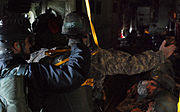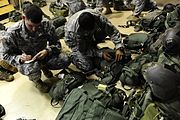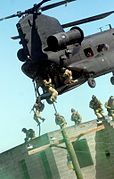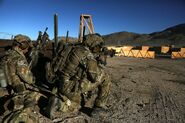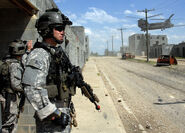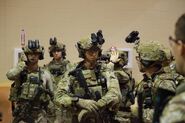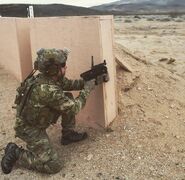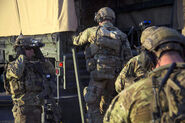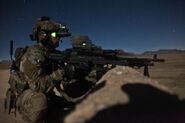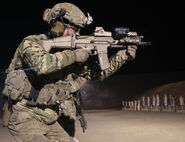| 75th Ranger Regiment | |
|---|---|
 75th Ranger Regiment Shoulder Sleeve Insignia | |
| Active |
February 1986 – present June 19, 1942 (1st Battalion) |
| Country | United States |
| Branch | U.S. Army |
| Type |
Special Operations Force Light Infantry |
| Role |
Primary tasks:
|
| Size | Three light infantry battalions and one Special Troops Battalion |
| Part of |
|
| Garrison/HQ | HQ – Fort Benning, Georgia |
| Nickname(s) |
Army Rangers Airborne Rangers |
| Motto(s) |
"Rangers lead the way!" "Sua Sponte" (English: "Of their own accord") |
| Engagements |
Korean War Kosovo War |
| Commanders | |
| Current commander | COL Chris Vanek |
| Insignia | |
| Distinctive Unit Insignia |
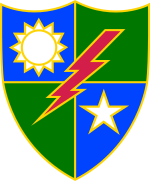 |
| Beret Flash |
 |
The 75th Ranger Regiment (Airborne), also known as Rangers, is a light infantry special operations force of the United States Army. The regiment is headquartered at Fort Benning, Georgia and is composed of one special troops battalion and three light infantry special operations battalions with specialized skills that enable them to perform a variety of special operations missions. It operates as a special operations force of the United States Army Special Operations Command.[1]
Origin[]
American Ranger history predates the Revolutionary War with Ethan Allen and his guerrilla fighting group The Green Mountain Boys in Vermont. Captain Benjamin Church formed Church's Rangers, which fought hostile Native American tribes during King Philip's War.[2] Major Robert Rogers formed a Ranger unit 1757 to fight during the French and Indian War. They would be known as the "Rogers' Rangers." The Continental Congress formed eight companies of expert riflemen in 1775 to fight in the Revolutionary War. In 1777, this force of hardy frontiersmen commanded by Dan Morgan was known as The Corps of Rangers. Francis Marion, "The Swamp Fox", organized another famous Revolutionary War Ranger element known as "Marion's Partisans."
During the War of 1812, companies of United States Rangers were raised from among the frontier settlers as part of the regular army. Throughout the war, they patrolled the frontier from Ohio to Western Illinois on horseback and by boat. They participated in many skirmishes and battles with the British and their American Indian allies. The American Civil War included rangers such as John Singleton Mosby who was the most famous Confederate ranger during the Civil War. His company's raids on Union camps and bases were so effective, part of North-Central Virginia soon became known as Mosby's Confederacy.
After the Civil War, more than half a century passed without ranger units in the United States.
World War II battalions[]
1st Ranger Battalion[]
On 8 December 1941, the United States entered World War II the day after Pearl Harbor was attacked by Japan. At the time, Major William Orlando Darby, the founder of the modern rangers, was assigned to be on duty in Belfast, Northern Ireland. Darby, frustrated with his lack of hands on experience as General Russell Hartle’s aide, was put in charge of a new unit. General George C. Marshall envisioned an elite unit of fifty men selected voluntarily from the 34th Infantry Division. He believed Darby was the man to do the job. On 8 June 1942, Darby was officially put in charge of the first Ranger Battalion under General Hartle.[3]
On 19 August 1942, fifty rangers fought alongside Canadian and British commandos in the ill-fated Dieppe raid on the coast of occupied France. In November, the entire first Ranger Battalion entered combat for the first time when they landed at Arzew, Algeria. The first were split into two groups in hopes of assaulting Vichy-French batteries and fortifications before the first Infantry Division would land on the beach. The operation was successful. The unit sustained minimal casualties.[4]
On 11 February 1943, the rangers moved 32 miles to raid an Italian encampment at Sened Station. Moving at night, the rangers slipped to within 50 yards of the Italian outpost and began their attack. It took the battalion only 20 minutes to overtake the garrison and achieve their objective. Fifty Italians were killed and another ten were taken prisoner. Darby, along with other officers, were awarded the Silver Star Medal for this action. The battalion itself gained the nickname the “Black Death” by the Italians.[3]
At the time, the Italians still held the pass at Djebel El Ank, located at the far east edge of El Guettar. The Rangers linked up with engineers elements of the 26th Infantry, first Infantry Division, to attack the area. The first Rangers orders were to move overland, on foot 12 miles to outflank the enemy's position. In eight hours of fighting, the Americans captured the objective; the first Rangers took 200 prisoners.[3]
Creation of the 3rd and 4th Ranger Battalions[]
With the success of the first Ranger Battalion during the Tunisian campaign, Darby requested up the chain of command, that the rangers be expanded to a full regiment. The request was granted. The third and fourth Ranger Battalions, were authorized shortly after and were trained and led by veteran officers and NCOs from the first battalion. After getting the "green light" to expand his unit, Darby ran into a problem. The Rangers only took volunteers, Darby knowing that the best man for the job was not always a volunteer, sought out men around Oran. Although he was still limited in that he could only accept volunteers, he began to find ways around this. For instance, he began to give speeches, put up posters and encouraged his officers to scout around for eligible candidates. By June 1943, the three ranger battalions were fully operational. 1st Rangers were still under Colonel Darby; the 3rd under Major Herman Dammer, the fourth commanded by Major Roy Murray.[3]
1st and 4th Ranger Battalions were paired together, and positioned to spearhead General Terry Allen's 1st Division, on the Sicily campaign. Landing outside Gela, the rangers took the town just after midnight, and were quickly sent out to San Nicola. The rangers seized the town with the help of an armored division. Despite the fact that they were under a constant attack from enemy artillery, tank, and air forces, they still succeeded in the completion of their mission.[3] This 50 hour barrage would be one of the most unbearable experiences for the Rangers.
Following their success, the two ranger battalions were then ordered to take the town of Buerta, a fortress suspended on the 4,000 foot high edge of the cliff at Buerta beach. After almost withdrawing from the battle, and requesting artillery to level the city, a platoon of rangers volunteered to breach the city. Two privates, John See and John Constantine, sneaked in behind enemy lines and tricked the Italians and Germans into surrendering the city.[3]
Meanwhile the 3rd Ranger Battalion headed out into the area of Agrigento, where they marched through Campobello, Naro, and Favara successfully occupying each town. The 3rd was ordered to back track to the shores of Porto Empedocle. The beach itself was not occupied, but high in the cliffs heavy machine gun and cannon fire poured onto the rangers. Scrambling, the rangers made their way to each machine gun nest and they managed to disable all enemy opposition before the supporting infantry battalion even hit the shore.[3]
Colonel Darby was awarded the Distinguished Service Cross and was promoted by Patton; Darby, wanting to be closer to his men, turned down this promotion.[3]
Fall of the 1st, 3rd and 4th Battalions[]
On 30 January 1944, after Christmas break the Rangers were put together for a joint operation, to occupy the town of Cisterna, before the main infantry division moved in. That night the 1st and 3rd battalions moved into the town, passing many German soldiers that did not appear to notice the Rangers slip by.[5] The 4th Ranger Battalion met opposition almost immediately taking an opposite route by the road. During the night the 1st and 3rd Ranger battalions separated out about 2 miles, and when daylight caught the 1st Ranger Battalion out in an open field, the Germans began their ambush. Unable to escape and completely surrounded, the two Ranger battalions fought on until ammunition and resources were empty. The 4th Ranger Battalion tried to make a push to save their comrades but were unsuccessful and had to withdraw. After five hours of fighting, German tanks and motorized infantry defeated the Rangers. Out of the 760 men in the two battalions, only six escaped and the rest were killed or captured.[3]
This marked the end of the three Ranger battalions, the remaining 400 Rangers would be scattered around the 504th Parachute Regiment, and the 137 original Rangers would be sent home. On 26 October 1944, the three original Ranger battalions were deactivated at Camp Butner, North Carolina.[3]
2nd and 5th Ranger battalions[]

Rangers from 2nd Ranger Battalion demonstrate the rope ladders they used to scale Pointe du Hoc.
The 2nd and 5th Ranger Battalions were trained at Camp Forrest, Tennessee in 1 April 1943. They first saw action 6 June 1944, during Operation Overlord. During D-day 2nd Rangers companies D, E, and F, were ordered to take a strategic German outpost at Pointe du Hoc. This coastal cliff was supposed to have several 155m artillery cannons aimed down at the beach.[6] Once they arrived at the bottom of the cliff they had an enormous climb to make up rope ladders while receiving a barrage of machine gun fire from the Germans above. The 2nd Rangers were successful in taking the area even with the intense German resistance but the guns were not in sight. A patrol scouting the area found the 155m coastal guns a mile away; the patrol party quickly disabled the guns and any resistance in the area. In the article “Rangers take Pointe” Lenoard Lomell and Jack Kuhn are interviewed on the events that took place that day. Lomell goes on to explain
The guns had to have been taken off the Pointe. We were looking for any kind of evidence we could find and it looked like there were some markings on the secondary road where it joined the main road. We decided to leapfrog. Jack covered me, and I went forward. When I got a few feet forward, I covered him. It was a sunken road with very high hedgerows with trees and bushes and stuff like that. It was wide enough to put a column of tanks in, and they would be well hidden. We didn't see anybody, so we just took a chance, running as fast as we could, looking over the hedgerow. At least we had the protection of the high hedgerows. When it became my turn to look over, I said, "God, here they are!" They were in an orchard, camouflaged in among the trees.[7]
Meanwhile the rest of the 2nd and 5th Ranger Battalions spearheaded the 1–16th Infantry Regiment, 1st Infantry Division, on the beach at Omaha. This is where the famous ranger slogan comes from, when Major Max F. Schneider, commanding the 5th Ranger Battalion, met with General Norman Cota. When Schneider was asked his unit by Cota, someone yelled out "5th Rangers!", to which Cota replied, “Well then Goddammit, Rangers, lead the way!” This drive cut the German line allowing the conventional army to move in.[3] The 2nd and 5th Ranger Battalions would go on into the Normandy Campaign, working on special operation tasks. The two battalions fought in many battles such as Battle for Brest and the Battle of the Hurtgen Forest. The 2nd Rangers were responsible for capturing Le Conquet Peninsula, where they disabled a 280mm gun and took many German prisoners. The 2nd Ranger Battalion also went on to take several tactical German positions, cutting the German line in the Rhineland. In Saar west of Zerf, the 5th Battalion took an overlooking German position cutting of all supply routes to German forces.[3]
6th Ranger Battalion[]
The 6th Ranger Battalion was stationed in the Pacific, and served mostly in the Philippines and New Guinea. All operations completed by the 6th Battalion were done in company- or platoon-size behind enemy lines. They were the first soldiers to hit the Philippines, three days before the army would launch the first invasion. The 6th Ranger Battalion was a long-range reconnaissance, operating miles past the front line.[3]
At Cabanatuan, on the island of Luzon in January 1945, a company of the 6th Ranger Battalion executed the Raid at Cabanatuan. The Rangers penetrated 29 miles (47 km) behind enemy lines, including crawling a mile (1 mile (1.6 km)) across an open field on their stomachs. During their final assault the rangers destroyed a garrison of Japanese soldiers twice their size and rescued 500 POWs.[3]
The 6th Ranger Battalion's final mission was to secure a drop zone for paratroopers 250 miles (400 km) into enemy territory. They linked up with the 32nd Infantry Division and ended the war in the Philippines.
Korean War[]
The outbreak of hostilities in Korea in June 1950 again signaled the need for Rangers. Fifteen Ranger Companies were formed during the Korean War. The Rangers went to battle throughout the winter of 1950 and the spring of 1951. They were nomadic warriors, attached first to one regiment and then to another. They performed “out front” work – scouting, patrolling, raids, ambushes, spearheading assaults, and as counterattack forces to regain lost positions.[8]
Vietnam War[]
The history of Long Range Reconnaissance Patrol (LRRP—pronounced "Lurp"), LRP, and Ranger units deployed during the Cold War in Europe and Vietnam is based on three time periods: 1) LRRP from late 1965 to December 20, 1967; 2) LRP from late December 1967 through January 1969; and 3) Ranger from February 1, 1969, to 1972 when the Vietnam War drew down and the Vietnam Ranger units were deactivated. However, in 1974 their colors and lineage were passed to newly formed Ranger Battalions based in the United States.[9]
The first period above began in Vietnam in early 1966 with the creation of a provisional LRRP platoon by the 1st Cavalry Division; followed by the 1st Brigade, 101st Airborne Division; the 1st Infantry Division; and the 25th Infantry Division in June 1966. General William C. Westmoreland, commander of Military Assistance Command, Vietnam (MACV), ordered the creation of provisional LRRPs in all brigades and divisions on 8 July 1966. Thus, by the fall of 1966 the 4th and 9th Infantry Divisions had operational LRRP units, and in January 1967 the 196th Light Infantry Brigade had the same. The 101st Airborne Division “main body,” while still at Fort Campbell, Kentucky, converted its divisional Recondo School into a provisional LRRP unit in the summer of 1967, before the division deployed to Vietnam. This provisional company arrived in Vietnam in late November 1967.[10]
The second period began in late June 1967, when the chairman of the Joint Chiefs of Staff, General Earle G. Wheeler, authorized the formation of two long-range patrol companies for I and II Field Forces. Company E (Long Range Reconnaissance Patrol), 20th Infantry (Airborne) was activated on 25 September 1967 and assigned to I Field Force and stationed at Phan Rang. The nucleus of this unit came from the 1st Brigade, 101st Airborne Division LRRP Platoon, along with soldiers from the replacement stream. Company F (Long Range Patrol), 51st Infantry (Airborne) was activated on 25 September 1967 and assigned to II Field Force stationed at Bien Hoa. Its nucleus came from the LRRP platoon of the 173d Airborne Brigade, along with soldiers from the replacement stream. Each of the two Field Force LRP companies had an strength of 230 men, and was commanded by a major.[10] In an apparent response to division commanders' tactical requirements, and bolstered by the combat effectiveness of the provisional LRRP units, in the winter of 1967 the Army authorized separate company designations for Long Range Patrol (LRP) units in divisions and detachments in separate brigades. The divisional LRP companies were authorized 118 men and the brigade detachments 61 men. The wholesale renaming of existing divisional LRP units occurred on 20 December 1967 in the 1st Air Cavalry, 1st Infantry, 4th Infantry, 9th Infantry, 23d (Americal), and 25th Infantry Divisions. LRP detachments were created in the 199th Light Infantry Brigade on 10 January 1968, in the 173d Airborne Brigade on 5 February 1968, and in the 3d Brigade 82d Airborne Division and 1st Brigade 5th Mechanized Division on 15 December 1968.[10]
On 1 February 1969, the final period of the existence of these units began when the Department of the Army redesignated the LRP companies and detachments as lettered Ranger companies of the 75th Infantry Regiment under the Combined Arms Regimental System (CARS). All of the LRP companies and detachments were “re-flagged” as Ranger companies on that date, except Company D (Ranger), which was formed on 20 November 1969 upon the rotation of the Company D (Ranger), Indiana National Guard back to its home state. The third period ended when the Ranger companies were inactivated as their parent units were withdrawn from the war between November 1969 (Company O, 3d Brigade, 82d Airborne Division), and 15 August 1972 (Company H, 1st Air Cavalry Division).[10]
Modern battalions[]
In January 1974, General Creighton Abrams, Army Chief of Staff, directed the formation of a ranger battalion. The 1st Ranger Battalion was activated and parachuted into Fort Stewart, Georgia on July 1, 1974. The 2nd Ranger Battalion followed with activation on October 1, 1974. The 3rd Ranger Battalion and Headquarters and Headquarters Company received their colors on October 3, 1984, at Fort Benning, Ga. The 75th Ranger Regiment was designated in February 1986.[8]
The modern Ranger battalions were first called upon in 1980. Elements of 1st Ranger Battalion participated in the Iranian hostage rescue attempts. In October 1983, 1st and 2nd Ranger Battalions spearheaded Operation Urgent Fury, conducting a dangerous low-level parachute assault to seize Point Salines Airfield and rescue American citizens at True Blue Medical Campus.[8]
The entire 75th Ranger Regiment participated in Operation Just Cause. Rangers spearheaded the action by conducting two important operations. Simultaneous parachute assaults were conducted onto Torrijos/Tocumen International Airport, Rio Hato Airfield and General Manuel Noriega’s beach house, to neutralize Panamanian Defense Forces. The Rangers captured 1,014 Enemy Prisoners of War (EPW), and over 18,000 various weapons.[8]
Elements of Company B, and 1st Platoon Company A, 1st Ranger Battalion, deployed to Saudi Arabia from February 12, 1991 to April 15, 1991, in support of Operation Desert Storm. They conducted raids and provided a quick reaction force in cooperation with Allied forces.[8]
In August 1993, elements of 3rd Ranger Battalion, deployed to Somalia to assist United Nations forces attempting to bring order to the chaotic and starving nation. On October 3, 1993, the Rangers conducted a daylight raid with Delta Force. For nearly 18 hours, the Rangers delivered devastating firepower, killing an estimated 600 Somalis.[8]
On November 24, 2000 the 75th Ranger Regiment deployed Regimental Reconnaissance Company (RRC) Team 2 and a command and control element to Kosovo in support of Task Force Falcon.[8]
After the events of September 11, 2001, rangers were again called into action, in support of the War on Terror. On October 19, 2001, 3rd Battalion and 75th Ranger Regiment spearheaded ground forces by conducting an airborne assault to seize Objective Rhino in Afghanistan in support of Operation Enduring Freedom. On March 28, 2003, 3rd Ranger Battalion employed the first airborne assault in Iraq to seize Objective Serpent in support of Operation Iraqi Freedom.[8]
The Regimental Special Troops Battalion (RSTB) was activated on July 17, 2006. The RSTB conducts sustainment, intelligence, reconnaissance and maintenance missions which were previously accomplished by small detachments assigned to the regimental headquarters and then attached within each of the three ranger battalions. The activation of the RSTB is part of the shift of the ranger force's focus from short term “contingency missions” towards continuous combat operations without loss in lethality or flexibility.[8]
As of 2012, the 75th Ranger Regiment is conducting sustained combat operations in multiple countries, deploying from multiple locations in the United States—an unprecedented task for the regiment. Rangers continue conducting combat operations with almost every deployed special operation force, conventional and coalition force in support of both Operation Enduring Freedom and Operation Iraqi Freedom. The Ranger Regiment executes a wide range of diverse operations that include airborne and air assaults into Afghanistan and Iraq, mounted infiltrations behind enemy lines, complex urban raids and rescue operations.[8]
Ranger battalion operational tempo while deployed is high. The 1st Ranger Battalion conducted more than 900 missions in Afghanistan in one deployment: the battalion successfully captured nearly 1,700 enemy combatants (386 high-value targets) and killed more than 400.[11]
<templatestyles src="Template:Gallery/styles.css"></templatestyles>
- 75th Ranger Regiment
Modern Ranger selection and training[]
Qualifications[]

Rangers take part in a raid during Operation in Nahr-e Saraj, Afghanistan.
- Be a U.S. citizen
- Volunteer for assignment and be on active duty
- Have a General Technical Score of 107 or higher
- A Physical Training score of 240 or above (80% on each event)
- No physical limitations
- Qualify and volunteer for Airborne training
- A person of good character (no pending UCMJ action or drug or alcohol related incidents within 24 months)
- Must enlist into or currently hold a Military Occupational Specialty found in the 75th Ranger Regiment
- Able to attain at minimum a Secret Security Clearance[12]
Additionally Army officer applicants must:
- Be an officer of grade O-2 through O-4
- Qualify for a Top Secret Security Clearance
- Be serving at or have completed a tour at one duty station
- Meet Year Group specific criteria
- Hold an officer Military Occupational Specialty found in the 75th Ranger Regiment.[12]
Selection and training[]
Every volunteer for the regiment, from every new recruit to every officer and any senior leader selected to command in the regiment, will go through the Ranger Assessment and Selection Program (RASP) to assess their ability and provide the basic skills required to be an effective member of the 75th Ranger Regiment.[13]
For new soldiers, RASP is conducted after applicants successfully complete their basic Military Occupational Specialty course and graduate from the Army’s Parachutists Course (Airborne School). For soldiers, both enlisted and officer, who have successfully completed their first tour of duty, and meet the recruiting qualifications, a RASP date will be scheduled upon application and conditional acceptance to the 75th Ranger Regiment.[13]
RASP is broken down into two levels of training: RASP 1 for Junior Non-Commissioned Officers and Enlisted Soldiers (pay grades E-1 through E-5) and RASP 2 for Senior Non-Commissioned Officers, Officers and Warrant Officers. Candidates will train on physical fitness, marksmanship, small unit tactics, medical proficiency and mobility. Training is fast-paced and intense, ensuring Ranger candidates are prepared to employ their skills in both continued training and worldwide operations upon reaching their assigned Ranger unit. Throughout the course all candidates will be screened to ensure that only the best Soldiers are chosen for service in the Ranger Regiment. Regardless of the course, all candidates must meet the course requirements in order to serve in the Ranger Regiment. Upon successful completion of RASP, candidates will don the tan beret and 75th Ranger Regiment Scroll, knowing that they are a U.S. Army Ranger, and a member of one of the finest and most distinguished Army units in the world.[14]
Ranger Assessment & Selection Program 1 (RASP 1)[]
RASP 1 is an 8-week selection course for Junior Non-Commissioned Officers and Enlisted Soldiers (pay grades E-1 through E-5) that is broken down into two phases. Ranger candidates will learn the basics of what it takes to become a member of an elite fighting force. Candidates are tested on their mental and physical capabilities, while learning the advanced skills all Rangers are required to know to start their career with the 75th Ranger Regiment. Phase 1 focuses more on the critical events and skill level 1 tasks and Phase 2 focuses on training in Marksmanship, Breaching, Mobility, and Physical Fitness.[14]
Ranger Assessment & Selection Program 2 (RASP 2)[]
RASP 2 is a 21-day selection course for Senior Non-Commissioned Officers, Officers, and Warrant Officers. Candidates are tested on their physical and mental capabilities while learning the special tactics, techniques and procedures that set the Regiment apart, and learning the expectations of leading and developing young Rangers to be the Regimental leadership of tomorrow.[14]
Continued training[]
To maintain readiness, Rangers train constantly. Rangers focus on the Big 5: marksmanship, physical training, medical training, small unit tactics and mobility.[15]
Throughout their time in the Ranger Regiment, Rangers may attend many types of special schools and training. Depending on occupation and job requirements, members of the 75th Ranger Regiment enjoy unparalleled access to countless military schools, including Jumpmaster, Sniper, Pathfinder, Military Freefall, Scuba, Survival-Evasion-Resistance-Escape (SERE), and others. Additionally, members of the regiment at all levels are afforded unrivaled opportunities for joint training and non-traditional military and civilian schooling.[13]
Rangers are trained in "do-it-yourself" emergency medicine. Based on the premise that 90% of deaths from wounds are suffered before reaching medical facilities and that there are not enough medics and doctors to go around, the Regiment began to train Rangers to give themselves immediate, preliminary treatment. A 2011 study found a 3 percent death rate from potentially survivable causes in the 75th Regiment between October 2001 and April 2010. That compares with a 24 percent rate in a previously reported set of U.S. military deaths in Iraq and Afghanistan, which included troops who didn't have the Ranger-style training.[16]
RFS/RFM[]
Being a U.S. Army Special Operations Command unit, the Rangers maintain more stringent standards for their personnel. If at any point a Ranger is deemed to be failing to meet these standards he may be relieved and removed from the regiment. This is commonly referred to as being RFSed, short for "Released For Standards". A Ranger can be RFSed for virtually any reason, ranging from lack of motivation to disciplinary problems. Similarly, a Ranger physically incapable of performing his mission through prolonged illness or injury can also be removed from the regiment through a process referred to as RFM or "Relieved For Medical reasons".
Honors, mottos and creed[]
The 75th Ranger Regiment has been credited with numerous campaigns from World War II onwards. In World War II, they participated in 16 major campaigns, spearheading the campaigns in Morocco, Sicily, Naples-Foggia, Anzio and Leyte. During the Vietnam War, they received campaign participation streamers for every campaign in the war. The regiment received streamers with arrowheads (denoting conflicts they spearheaded) for Grenada and Panama. To date, the Rangers have earned six Presidential Unit Citations, nine Valorous Unit Awards, and four Meritorious Unit Commendation, the most recent of which were earned in Vietnam and Haditha, Iraq, respectively.
Sua Sponte, Latin for Of their own accord is the 75th Ranger Regiment's regimental motto. Contemporary rangers are triple-volunteers: for the U.S. Army, for Airborne School, and for service in the 75th Ranger Regiment.
The motto "Rangers lead the way!" dates from 6 June 1944, during the Normandy Landings on Dog White sector of Omaha Beach. Then Brigadier General Norman Cota (assistant CO of the 29th ID) calmly walked towards Maj. Max Schneider (CO of the 5th Ranger Battalion) while under heavy machine gun fire and asked “What outfit is this?” Someone yelled "5th Rangers!" To this, Cota replied “Well then Goddammit, Rangers! Lead the way!”
The term "Ranger"[]
Organizations define the term "Ranger" in different ways. For example, the annual "United States Army Best Ranger Competition," hosted by the Ranger Training Brigade, can be won by pairs of participants from the 75th Ranger Regiment, or by ranger-qualified entrants from other units in the U.S. military. For an individual to be inducted into the U.S. Army Ranger Association's "Ranger Hall of Fame" he "must have served in a Ranger unit in combat or be a successful graduate of the U.S. Army Ranger School." The Ranger Association further clarifies the type of unit: "A Ranger unit is defined as those Army units recognized in Ranger lineage or history."[17] Acceptance into the U.S. Army Ranger Association is limited to "Rangers that have earned the U.S. Army Ranger tab, WWII Rangers, Korean War Rangers, Vietnam War Long Range Reconnaissance Patrol members and Rangers, and all Rangers that participated in Operations Urgent Fury, Just Cause, Desert Storm, Restore Hope, Enduring Freedom, as well as those who have served honorably for at least one year in a recognized Ranger unit."[18]
Beret change[]
In June 2001, Army Chief of Staff General Eric Shinseki gave the order to issue black berets to regular soldiers. At the time, black berets were being worn exclusively by the Ranger Regiment. This created discontent within the 75th Ranger Regiment and even led to retired rangers going on nationwide road marches to Washington, D.C. to protest against the decision.[19] Because there was not a Presidential authorization to the regiment for exclusive wear of the black beret, they switched to wearing a tan beret to preserve a unique appearance, tan being reflective of the buckskin worn by the men of Robert Rogers' Rangers during the French and Indian War.[20] A memorandum for the purpose of changing the ranger beret from black to tan was sent and approved in March 2001.[21] Press releases were issued and articles were published all over the nation about this change in headgear after it was formally announced by the regimental commander, Colonel P.K. Keen.[22] In a private ceremony, past and present rangers donned the tan beret on July 26, 2001.[23]
Notable members[]

Rangers descend in an MH-6 Little Bird helicopter flown by pilots from the 160th Special Operations Aviation Regiment during a staged demonstration.
- General Stanley A. McChrystal; 10th colonel of the regiment; former commander, International Security Assistance Force (ISAF) and U.S. Forces Afghanistan (USFOR-A); former Director of the Joint Staff; former Commander of Joint Special Operations Command (JSOC).
- General John P. Abizaid, former platoon leader of Company A, and executive officer of Company C, former commander of Company A, 1st Ranger Battalion; former commander, Central Command.[24]
- General Wayne A. Downing, 3rd colonel of the regiment; former commander of 2nd Ranger Battalion; former commander of Special Operations Command. Ranger Hall of Fame Member
- Lieutenant General David Barno, former commander of the 2nd Ranger Battalion; former commander, Combined Forces-Afghanistan.
- Lieutenant General Robert W. Wagner, former company commander in the 2nd Ranger Battalion. Later becoming commander, U.S. Army Special Operations Command.
- Major General James T. Jackson, 8th colonel of the regiment; former platoon leader and company commander in the 2nd Ranger Battalion; was the commanding general of the U.S. Military District of Washington during the events of 9/11.
- Colonel William O. Darby, established and commanded "Darby's Rangers" that later evolved into the 75th Ranger Regiment. Ranger Hall of Fame Member
- Colonel James Earl Rudder, former commander of the 2nd Ranger Battalion during World War II, which he led the ranger assault on Pointe du Hoc on D-Day and was later the president of Texas A&M University.
- Colonel Michael D. Steele, former commander of Company B, 3rd Ranger Battalion during the Battle of Mogadishu.
- Colonel Robert L. Howard, former company commander in the 2nd Ranger Battalion; was nominated 3 times for the Medal Of Honor for his actions in Vietnam. Two were downgraded and the third was awarded. Ranger Hall of Fame Member
- Lieutenant Colonel AJ "Bo" Baker, was the commander during the reactivation of 2nd Ranger Battalion. Ranger Hall of Fame Member
- Sergeant Major of the Army Glen E. Morrell, former 1st Ranger Battalion command sergeant major and past sergeant major of the army.
- Matt Larsen, served in 1st Ranger Battalion, 2nd Ranger Battalion and the 75th Ranger Regiment; known as the father of Modern Army Combatives and founder of the United States Army Combatives School.
- Sergeant First Class Randy Shughart, Medal of Honor recipient, who was killed in action during the Battle of Mogadishu while serving as a Delta Force sniper defending a downed helicopter, started his career in 2nd Ranger Battalion. Ranger Hall of Fame Member.
- Corporal Pat Tillman, an American football player who left his National Football League career to enlist in the United States Army in May 2002; killed on 22 April 2004 as a member of the 2nd Ranger Battalion.
- Captain Joseph Yorio, former president and CEO of Xe Services, Blackwater Worldwide, served with 1st Ranger Battalion during Operations Just Cause and Desert Storm
- Sergeant First Class Leroy Petry, Medal of Honor recipient for actions during a firefight in Afghanistan.
Equipment[]
Assault Rifles
- M4 Carbine/MK18 Mod 1/Block ll
- FN SCAR
Machine Guns
Sniper Rifles/Marksman Rifles
Missile/Rocket Launchers
- M136 AT-4
- Ranger Antitank Weapons Systems (RAWS)
- FGM-148 Javelin
- FIM-92 Stinger
Handguns
Others
- M224 60mm mortar
- M252 81mm mortar
- M120 120mm mortar
- M320 Grenade Launcher Module
Gallery[]
See also[]
- Canadian Special Operations Regiment
- Company E, 52nd Infantry (LRP) / H Co. 75th Infantry (Ranger)—the most decorated and longest serving LRRP / Ranger unit in continuous combat.
- Battle of Mogadishu (during Operation Gothic Serpent)
- Battle of Signal Hill (1968)
- Black Hawk Down and the movie based on it.
- Irish Army Ranger Wing, special operations unit of the Irish Defense Forces that attended U.S.Ranger training.
- Operation Delaware
- Ranger Memorial
- Recondo School
- Scout Rangers, an elite infantry unit of the Philippine Army whose creation was influenced by the United States Army Rangers.
- United States Special Operations Forces
References[]
- ↑ Army Command and General Staff College. "Special Operations Forces Reference Manual Chapter 3: US Army Special Operations Forces". Federation of American Scientists. http://www.fas.org/irp/agency/dod/socom/sof-ref-2-1/SOFREF_Ch3.htm.
- ↑ "Biography of Captain Church". Ranger Hall of Fame. United States Army. https://www.benning.army.mil/rtb/hall_of_fame/halloffame_inaugural/captain_church.htm. "Church commanded an independent Ranger company during King Philip's War (1675–1678) on the New England frontier where they conducted highly successful combat operations against hostile Indians. Church's men were the first rangers successful in raiding the Indians' hiding places in forests and swamps."
- ↑ 3.00 3.01 3.02 3.03 3.04 3.05 3.06 3.07 3.08 3.09 3.10 3.11 3.12 3.13 McGowen, Sam (January 1997). "Darby’s Rangers surrounded at Cistema, World War II". Academic Search Complete. p. 38.
- ↑ McGowen, Sam, January 1997,Darby’s Rangers surrounded at Cistema, World War II; Vol. 11 Issue 5, p38, Retrieved from Academic Search Complete
- ↑ "Interview with Private Harry Perlmutter, Part I". Special Operations History Foundation. http://specialoperationshistory.info/omeka/items/show/71. Retrieved 19 July 2013.
- ↑ Lehman,Milton,1946,The Rangers Fought Ahead Of Everybody, Saturday Evening Post; Vol. 218 Issue 50, p28-52:Retrieved from academic Search complete
- ↑ Frederick, Michael & Masci, Joseph, may 2000,Ranger take Point, World War II; , Vol. 15 Issue 1, p50, Retrieved from Academic Search complete
- ↑ 8.0 8.1 8.2 8.3 8.4 8.5 8.6 8.7 8.8 8.9 GoArmy.com. 75th Ranger Regiment Heritage. http://www.goarmy.com/ranger/heritage.html.
- ↑ Ankony, Robert C., Lurps: A Ranger's Diary of Tet, Khe Sanh A Shau, and Quang Tri, revsied ed., Rowman & Littlefield Publishing Group, Landham, MD (2009).
- ↑ 10.0 10.1 10.2 10.3 "The Vietnam Experience, 1966–1972 LRRP" This material is from Major James F. Gebhardt (Retired), Eyes Behind the Lines: US Army Long-Range Reconnaissance and Surveillance Units, Combat Studies Institute Press, Fort Leavenworth, KS, 2005, Chapter 3.
- ↑ "Hunter-based Army Rangers awarded for actions in Afghanistan". savannahnow.com. http://savannahnow.com/share/blog-post/corey-dickstein/2012-03-19/hunter-based-army-rangers-awarded-actions-afghanistan#.T3ELVNX3NAJ. Retrieved 26 March 2012.
- ↑ 12.0 12.1 GoArmy.com. Join the Rangers. http://www.goarmy.com/ranger/joining-the-rangers.html.
- ↑ 13.0 13.1 13.2 GoArmy.com. Training. http://www.goarmy.com/ranger/training.html.
- ↑ 14.0 14.1 14.2 GoArmy.com. RASP 1&2. http://www.goarmy.com/ranger/training/rasp.html.
- ↑ The Big 5 | Benning.Army.Mil
- ↑ Lindsey Tanner. "Do-it-yourself battlefield medicine saves lives". Associated Press. http://www.msnbc.msn.com/id/44149419/ns/us_news-life/t/do-it-yourself-battlefield-medicine-saves-lives/.
- ↑ U.S. Army Ranger Association (2011). "Ranger Hall of Fame". U.S. Army Ranger Association, Inc.. http://www.ranger.org/Default.aspx?pageId=578463. Retrieved 19 March 2011.
- ↑ U.S. Army Ranger Association (2011). "Join USARA". U.S. Army Ranger Association, Inc.. http://www.ranger.org/Default.aspx?pageId=581102. Retrieved 19 March 2011.
- ↑ "Beret History". http://www.suasponte.com/m_beret.htm. Retrieved 21 November 2012.
- ↑ "Beret Controversy". http://rense.com/general9/blue.htm. Retrieved 21 November 2012.
- ↑ "DA Approves Ranger’s New Headgear". http://www.army.mil/features/beret/beret.htm. Retrieved 21 November 2012.
- ↑ "Adopting the Beret". http://ww2.dcmilitary.com/dcmilitary_archives/stories/032301/5859-1.shtml. Retrieved 21 November 2012.
- ↑ "Private Ceremony". http://ww2.dcmilitary.com/dcmilitary_archives/stories/080301/9188-1.shtml. Retrieved 21 November 2012.
- ↑ Urgent Fury: the Battle for Grenada; Mark Adkin, 1989 pp. 195 ff.;ISBN 0-669-20717-9
External links[]
| Wikimedia Commons has media related to 75th Ranger Regiment. |
- 75th Ranger Regiment
- GlobalSecurity.org's Ranger history
- Institute of Heraldry
- Lineage and Honors at the United States Army Center of Military History
- Photographic history of 1st Air Cavalry Division Lurp / Rangers in Vietnam 1968
- 75th Ranger Regiment additional pictures and info
- U.S. Army Ranger History SuaSponte.com
| |||||||||||||||||||||||||||||||||||||||
| ||||||||||||||||||||||||||
Further reading[]
- Ankony, Robert C., "No Peace in the Valley," Vietnam magazine, Oct. 2008, 26-31.
- Bahmanyar, Mir. Darby's Rangers 1942–45. Oxford, United Kingdom: Osprey Publishing, 2003. ISBN 978-1-84176-627-0.
- Bahmanyar, Mir. Shadow Warriors: A History of the U.S. Army Rangers. Oxford, United Kingdom: Osprey Publishing, 2005. ISBN 978-1-84176-860-1. This book lists the lineage and history of the 75th Ranger Regiment.
- Bahmanyar, Mir. U.S. Army Ranger 1983–2002. Oxford, United Kingdom: Osprey Publishing, 2003. ISBN 978-1-84176-585-3.
- Bowden, Mark. Black Hawk Down: A Story of Modern War. Berkeley, California: Atlantic Monthly Press, 1999. ISBN 0-87113-738-0.
- Bryant, Russ. To Be a U.S. Army Ranger. St. Paul, Minnesota: Motorbooks International, 2002. ISBN 0-7603-1314-8.
- Bryant, Russ, and Susan Bryant. Weapons of the U.S. Army Rangers. St. Paul, Minnesota: Zenith Press, 2005. ISBN 0-7603-2112-4.
- Bryant, Russ. 75th Rangers. St. Paul, Minnesota: Motorbooks International, 2005. ISBN 0-7603-2111-6.
- Grenier, John. The First Way of War: American War Making on the Frontier, 1607–1814. Cambridge: Cambridge University Press, 2005. ISBN 0-521-84566-1. Extensive discussion of American colonial rangers.
- Haney, Eric. Inside Delta Force: The Story of America's Elite Counterterrorist Unit. Delacorte Press, 2002. ISBN 978-0-385-33603-1.
- Shanahan, Bill, and John P. Brackin. Stealth Patrol: The Making of a Vietnam Ranger. Cambridge, Massachusetts: Da Capo Press, 2003. ISBN 0-306-81273-8.
The original article can be found at 75th Ranger Regiment (United States) and the edit history here.

